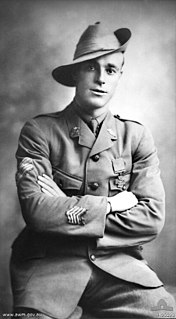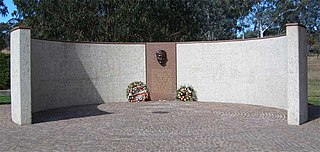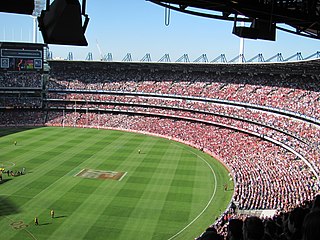Related Research Articles

Anzac Day is a national day of remembrance in Australia and New Zealand that broadly commemorates all Australians and New Zealanders "who served and died in all wars, conflicts, and peacekeeping operations" and "the contribution and suffering of all those who have served". Observed on 25 April each year, Anzac Day was originally devised to honour the members of the Australian and New Zealand Army Corps (ANZAC) who served in the Gallipoli Campaign, their first engagement in the First World War (1914–1918).

The Gallipoli campaign, also known as the Dardanelles campaign, the Battle of Gallipoli or the Battle of Çanakkale, was a military campaign in the First World War that took place on the Gallipoli peninsula, from 17 February 1915 to 9 January 1916. The Entente powers, Britain, France and Russia, sought to weaken the Ottoman Empire, one of the Central Powers, by taking control of the Turkish straits. This would expose the Ottoman capital at Constantinople to bombardment by Allied battleships and cut it off from the Asian part of the empire. With Turkey defeated, the Suez canal would be safe, and a year-round Allied supply route could be opened through the Black Sea to warm water ports in Russia.

Arthur Bryce Courtenay, was a South African-Australian advertising director and novelist. He is one of Australia's best-selling authors, notable for his book The Power of One.

Charles Edwin Woodrow Bean, usually identified as C. E. W. Bean, was an Australian World War I war correspondent and historian.

The Australian and New Zealand Army Corps (ANZAC) was a First World War army corps of the Mediterranean Expeditionary Force. It was formed in Egypt in December 1914, and operated during the Gallipoli campaign. General William Birdwood commanded the corps, which primarily consisted of troops from the First Australian Imperial Force and 1st New Zealand Expeditionary Force, although there were also British and Indian units attached at times throughout the campaign. The corps disbanded in 1916, following the Allied evacuation of the Gallipoli peninsula and the formation of I ANZAC Corps and II ANZAC Corps. The corps was reestablished, briefly, in the Second World War during the Battle of Greece in 1941.

Hugo Vivian Hope Throssell, VC was an Australian soldier and farmer. He was the only Australian light horseman to receive the Victoria Cross, the highest award for gallantry available to British and Commonwealth forces, during the First World War.

Reginald Roy Inwood, VC was an Australian soldier and recipient of the Victoria Cross, the highest award for gallantry in battle that can be awarded to a member of the Australian armed forces. Inwood enlisted in the Australian Imperial Force in August 1914, and along with the rest of the 10th Battalion, he landed at Anzac Cove, Gallipoli, on 25 April 1915. He fought at Anzac until being evacuated sick to Egypt in September. He remained there until he rejoined his unit on the Western Front in June 1916. In August, he fought in the Battle of Mouquet Farm.

The Anzac spirit or Anzac legend is a concept which suggests that Australian and New Zealand soldiers possess shared characteristics, specifically the qualities those soldiers allegedly exemplified on the battlefields of World War I. These perceived qualities include endurance, courage, ingenuity, good humour, larrikinism, and mateship. According to this concept, the soldiers are perceived to have been innocent and fit, stoical and laconic, irreverent in the face of authority, naturally egalitarian and disdainful of British class differences.
Alexander William Campbell was the final surviving Australian participant of the Gallipoli campaign during the First World War. Campbell joined the Australian Army at the age of 16 in 1915, and served as a stores carrier for two months during the fighting at Gallipoli. He was invalided home and discharged in 1916. He later worked in large number of roles, was twice married and had nine children. He is the great-grandfather of actress, singer and model Ruby Rose.

The Kemal Atatürk Memorial is a memorial directly opposite the Australian War Memorial on Anzac Parade, the principal memorial and ceremonial parade in Canberra, the capital of Australia.

William Edward Sing, DCM was an Australian soldier of Chinese and English descent who served in the Australian Imperial Force during World War I, best known as a sniper during the Gallipoli Campaign. He took at least 150 confirmed kills during that campaign, and may have had over 200 kills in total. However, contemporary evidence puts his tally at close to 300 kills. Towards the end of the war, Sing married a Scottish woman, but the relationship did not last long. Following work in sheep farming and gold mining, he died in relative poverty and obscurity in Brisbane during World War II.
Albert Barnett Facey, publishing as A.B. Facey was an Australian writer and World War I veteran, whose main work was his autobiography, A Fortunate Life, now considered a classic of Australian literature. As of 2020 it has sold over one million copies and was the subject of a television mini-series.

The Anzac Day match is an annual Australian rules football match between Collingwood and Essendon, two clubs in the Australian Football League, held on Anzac Day at the Melbourne Cricket Ground (MCG).

William Charles Scurry, was an Australian soldier who invented the self-firing "drip rifle" while serving as a private in the Gallipoli campaign during the First World War. He was decorated for his invention and was later commissioned and served as an officer during the fighting on the Western Front, where he commanded a mortar battery before being wounded in action.
Walter Parker was an Australian soldier and the third last surviving veteran of the Australian and New Zealand Army Corps (ANZAC) who served in World War I.

Roy Longmore was an Australian soldier and centenarian, who after Alec Campbell, was noted as the second last living Australian and New Zealand Army Corps (ANZAC) veteran who saw service in World War I.
Courtney's and Steel's Post Cemetery is a Commonwealth War Graves Commission cemetery located near ANZAC Cove on the Gallipoli peninsula in Turkey. It contains the graves of some of the former British Empire troops who died during the Gallipoli Campaign.

George Courtney Benson (1886–1960) was an Australian painter, muralist and cartoonist, and an official war artist during World War I.

Anzacs bathing is a 1916 painting by Australian artist George Washington Lambert. The painting depicts three Anzac soldiers bathing at Anzac Cove during the Gallipoli Campaign during World War I.
Three young men frolic in the foaming blue sea, in a break from the brutalities of battle; the light gilds and defines, in scrupulous detail, the musculature of the soldiers’ bodies

Daniel Reynaud is an Australian historian whose work on Australian war cinema and on Australian World War I soldiers and religion has challenged aspects of the Anzac legend, Australia’s most important national mythology built around the role of Australian servicemen, popularly known as Anzacs
References
- Kyle, Roy. Edited by Courtney, Bryce. (2003). An Anzac's Story. Penguin Books, Victoria. ISBN 0-14-300187-6.